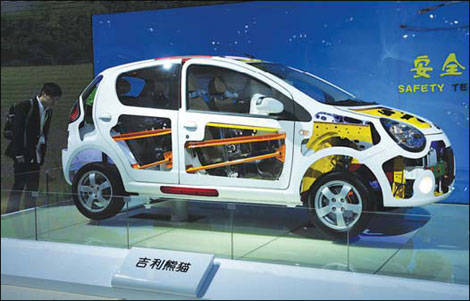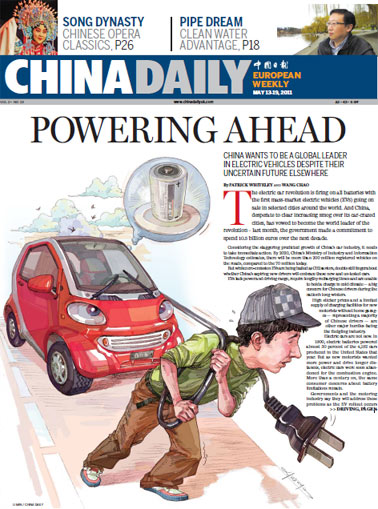Electric car timeline
Updated: 2011-05-13 10:27
(China Daily European Weekly)
1897
The first electric taxis hit the streets of New York City. In 1900, of the 4,192 cars produced in the United States, 28 percent are powered by electricity.
1899
Thomas Edison creates a long-lasting, powerful battery for commercial automobiles, but abandons his quest a decade later after success of Henry Ford's gasoline-powered Model T.
1920
Electric car ceases to be a viable commercial product. New motorists want longer distance vehicles with more horsepower.
1966
US Congress introduces the earliest bills recommending use of electric vehicles as a means of reducing air pollution.
1972
Victor Wouk, the "Godfather of the Hybrid", builds the first full-powered, full-size hybrid vehicle out of a 1972 Buick Skylark provided by General Motors (GM)
1988
GM co-designs its first electric car, the EV1, which one employee called "the world's most efficient production vehicle".
1995
The BYD company is set up. Today makes 65 percent of the world's nickel-cadmium batteries and 30 percent of the world's lithium-ion mobile phone batteries. BYD Auto was established in 2003.
1997
Toyota unveils the Prius, the world's first commercially mass-produced and marketed hybrid car. Nearly 18,000 units are sold during the first production year.
1997 - 2000
More electric cars developed including Honda's EV Plus, General Motors EV1, Ford's Ranger pickup EV, Nissan's Altra EV, Chevy's S-10 EV and Toyota's RAV4 EV.
1998
Suzhou Eagle Electric Vehicle Manufacturing Co Ltd is established and becomes a leading manufacturer in China specializing in making electric vehicles.
2005
Major auto companies re-start electric car development programs after growing acceptance of global warming, oil price spikes and the wide spread of green marketing campaigns.
2008
Warren Buffett's Berkshire Hathaway purchases a 10 percent stake in BYD. It releases the F3DM, the world's first mass-produced plug-in hybrid compact sedan.
2009
China vows to become EV world leader. In 2011 the country makes a commitment to spend 10.5 billion euros over the next decade.
US government allocates $2 billion (1.4 billion euros) for development of electric vehicle batteries and related technologies. The Department of Energy adds another $400 million to fund building the infrastructure necessary to support plug-in electric vehicles.
British government offers a 2,000 pound (2,271 euros) subsidy on EVs. Government estimates that 40 percent of all cars in Britain will need to be electric or hybrid for the country to reach its goal of cutting 80 percent of its CO2 emissions by 2050.
2010
Chinese government offers 60,000 yuan (6,220 euros) subsidies toward full electric cars in China's EV trial cities of Shanghai, Changchun, Shenzhen, Hangzhou and Hefei. The trial EV network will later be expanded to 25 cities.
2011
Approximately 45 new energy cars unveiled at Shanghai Auto Show. The FAW Group showcases nine new green vehicles and announces plans to spend 9.8 billion yuan on developing 16 environment-friendly passenger and business models by 2015.
Dongfeng Motor Corp plans to launch its first electric car next year and expected its electric car sales to reach 100,000 units by 2015.
|
 A Geely Panda vehicle on display at the Beijing Auto Show 2010. [An Xin / For China Daily] |
China Daily
E-paper

War of the roses
European Chinese rose growers are beating their Chinese rivals at their own game
Preview of the coming issue
High-tech park gets big boost
At the source
Specials

New wave
Coastal city banks on marine sector to ride next stage of economic development

Drunk driving
Drunk drivers face a detention for one to six months and a revokation of their drivers' license.

V-Day parade
A military parade marking the 66th anniversary of the Soviet victory over Nazi.
